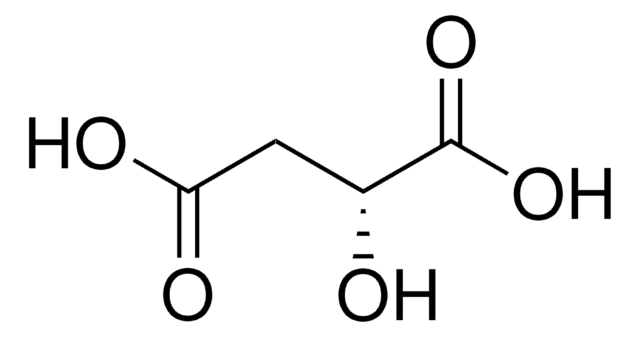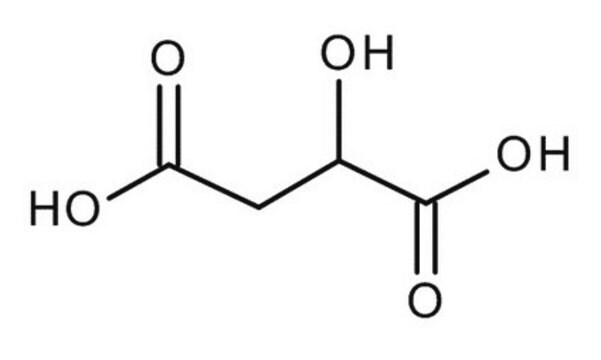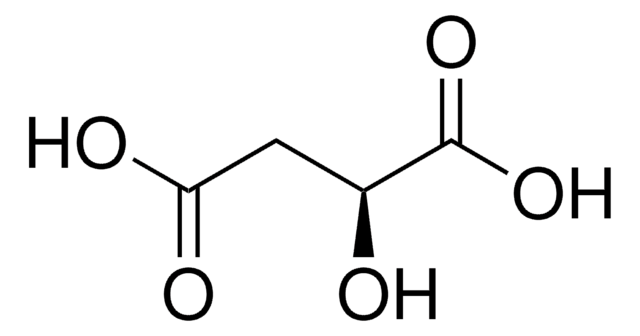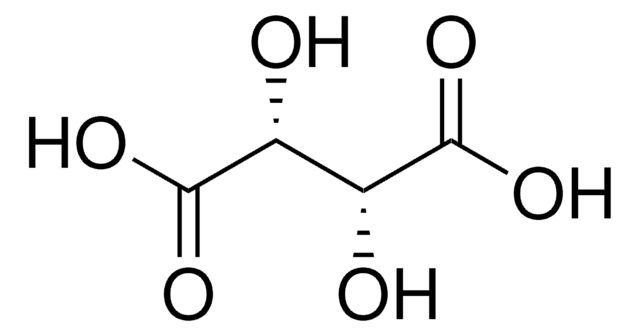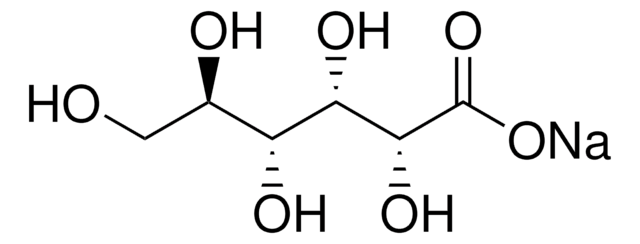1374601
USP
Malic acid
United States Pharmacopeia (USP) Reference Standard
Sinonimo/i:
DL-Malic acid, (±)-2-Hydroxysuccinic acid, DL-Hydroxybutanedioic acid
About This Item
Prodotti consigliati
Grado
pharmaceutical primary standard
Densità del vapore
4.6 (vs air)
Tensione di vapore
<0.1 mmHg ( 20 °C)
Famiglia di API
malic acid
Temp. autoaccensione
644 °F
Produttore/marchio commerciale
USP
Punto di fusione
131-133 °C (lit.)
applicazioni
pharmaceutical (small molecule)
Formato
neat
Temperatura di conservazione
2-8°C
Stringa SMILE
OC(CC(O)=O)C(O)=O
InChI
1S/C4H6O5/c5-2(4(8)9)1-3(6)7/h2,5H,1H2,(H,6,7)(H,8,9)
BJEPYKJPYRNKOW-UHFFFAOYSA-N
Cerchi prodotti simili? Visita Guida al confronto tra prodotti
Descrizione generale
For further information and support please go to the website of the issuing Pharmacopoeia.
Applicazioni
- Fumaric Acid
- Alanine
- Aspartic Acid
- Maleic Acid
- Calcium Citrate Malate
- Cranberry Fruit Powder
Risultati analitici
Altre note
Prodotti correlati
Avvertenze
Warning
Indicazioni di pericolo
Consigli di prudenza
Classi di pericolo
Eye Irrit. 2
Codice della classe di stoccaggio
11 - Combustible Solids
Classe di pericolosità dell'acqua (WGK)
WGK 1
Punto d’infiammabilità (°F)
Not applicable
Punto d’infiammabilità (°C)
Not applicable
Certificati d'analisi (COA)
Cerca il Certificati d'analisi (COA) digitando il numero di lotto/batch corrispondente. I numeri di lotto o di batch sono stampati sull'etichetta dei prodotti dopo la parola ‘Lotto’ o ‘Batch’.
Possiedi già questo prodotto?
I documenti relativi ai prodotti acquistati recentemente sono disponibili nell’Archivio dei documenti.
I clienti hanno visto anche
Protocolli
Separation of Pyruvic acid, United States Pharmacopeia (USP) Reference Standard; Tartaric acid, United States Pharmacopeia (USP) Reference Standard; Citric acid, United States Pharmacopeia (USP) Reference Standard; Malic acid, United States Pharmacopeia (USP) Reference Standard; L-Pyroglutamic acid, ≥99.0% (T); Lactic acid, United States Pharmacopeia (USP) Reference Standard; Acetic acid, ≥99.99% trace metals basis; Succinic acid, United States Pharmacopeia (USP) Reference Standard
Il team dei nostri ricercatori vanta grande esperienza in tutte le aree della ricerca quali Life Science, scienza dei materiali, sintesi chimica, cromatografia, discipline analitiche, ecc..
Contatta l'Assistenza Tecnica.





